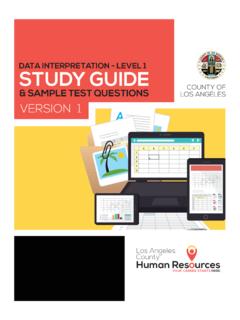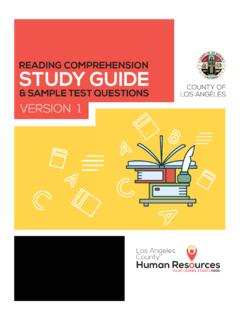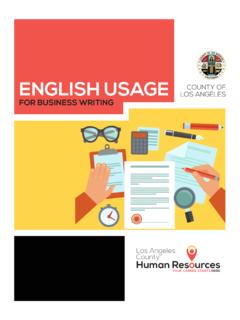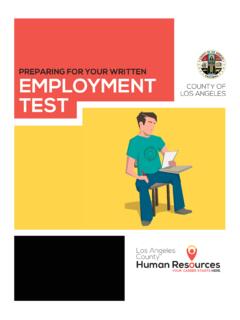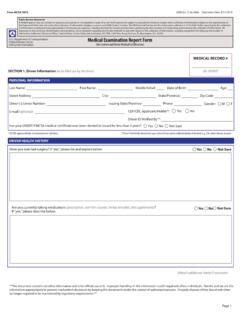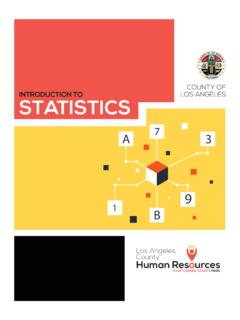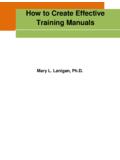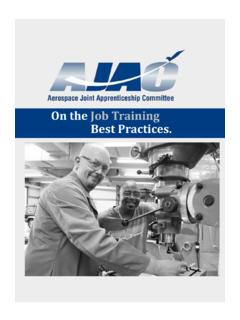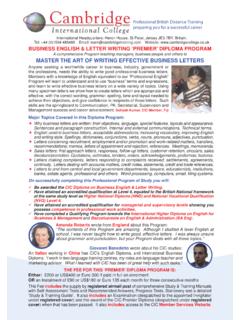Transcription of A Guide to Effective Office Practices from the …
1 COUNTY OF LOS ANGELESE verything you need to know about the Los Angeles County online Job Application CAREER STARTS ResourcesLos AngelesCounty2 Table of Contents Introduction .. 3 Completing Office Assignments .. 5 Managing Office Time .. 10 Managing Office Documents .. 17 Using Office Equipment, Tools, and 22 Conclusion .. 24 Bibliography .. 25 About the Authors .. 25 3 Introduction The County of Los Angeles Department of Human Resources is pleased to offer this Office Practices information Guide . The role and importance of Office Practices has changed dramatically over the years. Innovations in technology have changed the nature of Office work from processing paperwork to planning and organizing multi-step assignments.
2 Understanding contemporary Office Practices is essential to succeed in today s workplace. Purpose The purpose of this Guide is to provide an introduction to Office Practices by presenting you with general information covering this subject area and to spark your interest for further exploration. Objectives The Office Practices information Guide has been designed to help you understand the definition of Office Practices . complete Office assignments. manage your time in the Office . use electronic and paper filing systems. be aware of relevant Office equipment, tools, and resources. Disclaimer The Office Practices information Guide provides an introduction on this subject matter; further study of this subject and related concepts may be necessary to gain the understanding needed to achieve your learning and/or career goals.
3 Although this Guide presents useful and practical information from this subject area, there is no guarantee that someone who reads it will be able to perform better on the job or on a County examination. By merely using this Guide , you consent to understanding and agreeing with this disclaimer. Who Should Use This Guide ? This Guide was written for those who are new to working in an Office environment. However, it may be useful for anyone seeking to better understand fundamental Office Practices . This Guide covers common Office Practices used by most Office professionals, regardless of the setting in which they work ( , health care services, protective services, human resources, information technology, etc.)
4 It will not address the unique Office Practices related to a specific work setting. 4 The Definition of Office Practices To ensure we have a shared understanding of what Office Practices are, we have provided a formal definition that will be used throughout this Guide : Office Practices are the day-to-day clerical and administrative activities performed by Office professionals to support work-related functions and organizational decision makers. To provide further clarification, the components of this definition are explained below: Day-to-day clerical and administrative activities a wide range of activities including: o Performing Office tasks ( , responding to phone/email requests, making reservations, typing a memo, etc.)
5 O Operating Office equipment ( , computer, photocopier, fax machine, etc.). o Managing, organizing, filing, and storing paper and electronic documents. Office professionals employees who work in a wide range of jobs that require knowledge of Office Practices as part of their job duties; however, this Guide will focus on the Office Practices of entry-level clerical and support staff ( , clerks, staff assistants, adoptions assistant, etc.). Work-related functions the major activities of the organization ( , provides heath care services, protects life and property, trains employees, etc.). Organizational decision makers the directors, managers, and supervisors who make decisions for an organization.
6 Throughout this Guide , we will use the term manager to describe all organizational decision makers. 5 Completing Office Assignments Introduction What Would You Do? Your manager asks to speak with you. You quickly grab a pen and paper and walk down the hall to her Office . She explains, Something just came up and I need your help. She then discusses the details of a challenging assignment. To complete the work, you will need to accomplish several different tasks. What is your first step? What will you do to accurately complete the assignment on time? How will you report your results? Office professionals work on a variety of clerical ( , filing, organizing, data entry, etc.)
7 And administrative ( , preparing reports, problem solving, collecting information, etc.) assignments. The complexity of these assignments may vary from one to two steps ( , photocopying 50 training manuals) to more challenging work that requires multiple steps ( , creating a tracking system for inventory, assignments, or documents). This section will discuss a 5-step process to successfully complete the complex, multi-step Office assignments. Five Steps to Completing Assignments 1) Understanding the Assignment 2) Creating an Assignment Plan 3) Taking Action 4) Reviewing the Work 5) Reporting the Results Step 1: Understanding the Assignment When you receive an assignment, the first step is to understand the purpose of the assignment and the expectations your manager has about the outcome.
8 If you and your manager have a different understanding, it will likely result in the assignment not being completed properly. To ensure you fully understand the assignment, make sure you are listening to the instructions. taking notes on important information. asking questions if you need clarification. summarizing the details of the assignment. Next, we will elaborate on each of these four topics. Carefully consider the following suggestions and think of ways to apply them in your work as an Office professional. 6 Listening Listening is the key to understanding and is crucial for Office communication. To become a more Effective listener, you should discontinue other activities and give the speaker your full attention.
9 Maintain good eye contact. avoid interrupting or jumping to conclusions. pay attention to the main ideas ( , the big picture ) and the small details. Taking Notes It can be challenging for an Office professional to remember detailed information while working in a busy Office environment. Well written notes can serve as a reference to help you remember important information. When taking notes, write brief statements that cover the most important aspects of the instructions. write legibly so that you can read your notes at a later time. avoid focusing so much on writing that it affects your ability to listen. store your notes in an easily accessible place. Helpful Tip: Always have a pen and a pad of paper ready to take notes.
10 You never know when your manager may ask to speak with you. Asking Questions You may need to ask questions to fully understand an assignment. Asking appropriate questions also demonstrates your attentiveness, professionalism, and commitment to your job and the organization. The table below provides examples of Effective and less Effective questions: Less Effective Questions Effective Questions What do you want? How may I help you? What do you want me to do? Let me make sure I understand this assignment. I need Is this correct? What is the point of doing this? What are the goals and objectives of this assignment? How much time do I get before I have to finish this assignment?

